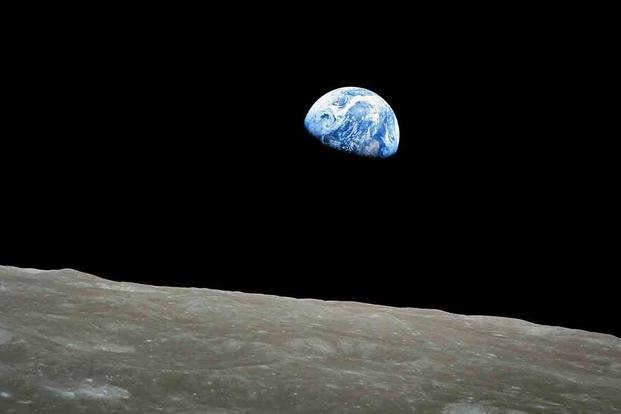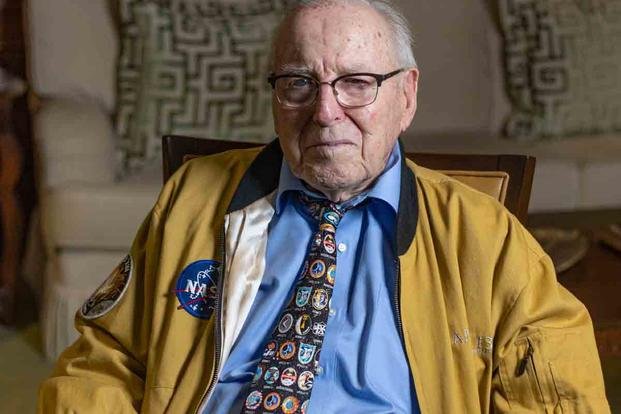The old joke says "Navy" stands for "Never Again Volunteer Yourself." but if astronaut Jim Lovell had never volunteered, his life (and maybe the lives of countless others) might have been entirely different -- or ended prematurely.
When Lovell was in high school, he lived in a one-room apartment with his mother in Milwaukee. He wanted to go to college, but the family had no money and he had "no aspect of a future career." That changed when a military recruiter came to his school to talk to his class of seniors.
“He said, ‘Lookit, the Navy needs more naval aviators. Is anyone here interested in naval aviation?” Lovell recalls. “At this time, the [Korean] war was going on and the Navy needed more naval aviators.”
The recruiter told the class about a two-year Navy program for training new fighter pilots. The Navy wasn't new to Lovell, but aviation was. He raised his hand to volunteer, altering the course of his life to the moon and back.
Lovell spoke to the American Veterans Center about joining the Navy, becoming an astronaut and the rescue of the ill-fated Apollo 13 mission.
Humans are returning to the moon for the first time since the Apollo 17 mission of 1972. Beyond simply studying the moon, the new three-mission Artemis Program is the first step in establishing a permanent human presence on the moon while paving the way for a mission to Mars.
The Artemis 2 mission, scheduled for 2024, will feature the first crewed mission to orbit the moon since Apollo 17, and they'll do it in the new Orion spacecraft. The crew itself is historic, including the first female astronaut to orbit the moon, the first Black astronaut to orbit the moon and the first non-American to orbit the moon. It's all in preparation for Artemis 3, the first lunar landing in more than 50 years.
When Lovell became an astronaut, humans were still trying to land on the moon for the first time. Central to such a historic achievement was that kid who volunteered for a two-year naval aviation program. After two years of engineering at the University of Wisconsin, he volunteered to spend more years at the U.S. Naval Academy to make aviation his career.
At the academy, Lovell studied liquid-fueled rockets and rocket-powered space exploration. He graduated, went to aviator training and was assigned to develop nighttime flying on aircraft carriers. After his first cruise, he volunteered for test pilot school. It was there he first applied to get into Project Mercury, NASA's program to put a man into orbit.
“When they finally picked the people, I wasn’t selected,” Lovell says. “Ahhhhhhh, I couldn’t believe it. I was sad … I went back home and I was testing airplanes when my companions flew for Mercury.”
When the second round of selections began for Project Gemini, the program that would develop space travel, he was selected. By 1965, Lovell became the pilot for the Gemini 7 mission. For Gemini 12 in 1966, Lovell was the command pilot and NASA was ready for the Apollo program, the project that would put men on the moon.
In 1968, 20 years after graduating from high school with few prospects, Lovell was the navigator for Apollo 8, the first human spaceflight to leave Earth's orbit and travel to the moon. They were also the first to witness an Earthrise as they traveled on the dark side of the moon. Crew members took a photo of the never-before-seen event and were named Time's "Men of the Year" that year.

Lovell's next flight to the moon, in 1970, was supposed to be the third moon landing. Instead, it would be his last spaceflight. Apollo 13 was supposed to be a mission to train the astronauts in geology, land them on the moon and gather samples for return to Earth.
While on their way to the moon, an oxygen tank exploded in the service module and sent the crew's oxygen tanks hurtling into space. With little oxygen, which was also used to generate power, the crew's options were limited and the moon landing was scrapped.
"You have to realize in this situation, the crew is interested in getting home," Lovell says. "They're not interested in landing on the moon. That's the last thing they're thinking about."
After moving navigation computers to the command module (the service module had the navigation computer for getting back to Earth), they piled into the command module, abandoned the service module and, with the help of mission control, made their way back to Earth.
As the astronauts were rescued by helicopter, Lovell was the last man standing on the module, floating in the middle of the ocean. As he stood there, he was just happy to be back on Earth.
"I remember the other two guys had departed, I'm by myself and I said, 'Well, it's the last command I think I'll have in a long time,'" Lovell laughs. "And sure enough it was."

Jim Lovell was one of 24 men to fly to the moon, one of 10 who are still alive and the first to make the trip twice. He retired from the Navy in 1973. He was awarded the Presidential Medal of Freedom by President Richard Nixon in 1970 and the Congressional Space Medal of Honor by President Bill Clinton in 1995, along with countless other awards and decorations.
Astronauts will return to the moon in 2024, first with the Artemis 2 mission that will orbit the moon and return. NASA plans for the Artemis 3 mission to land on the moon is currently planned for 2025. The crew for that mission has not yet been named.
-- Blake Stilwell can be reached at blake.stilwell@military.com. He can also be found on Twitter @blakestilwell or on LinkedIn.
Want to Learn More About Military Life?
Whether you're thinking of joining the military, looking for post-military careers or keeping up with military life and benefits, Military.com has you covered. Subscribe to Military.com to have military news, updates and resources delivered directly to your inbox.















